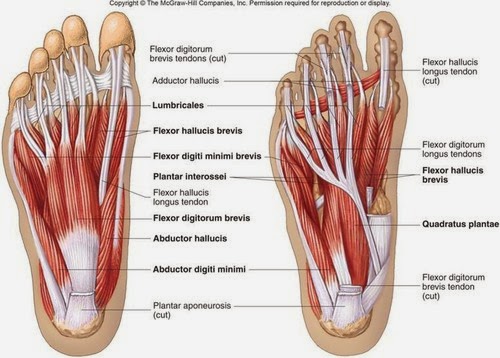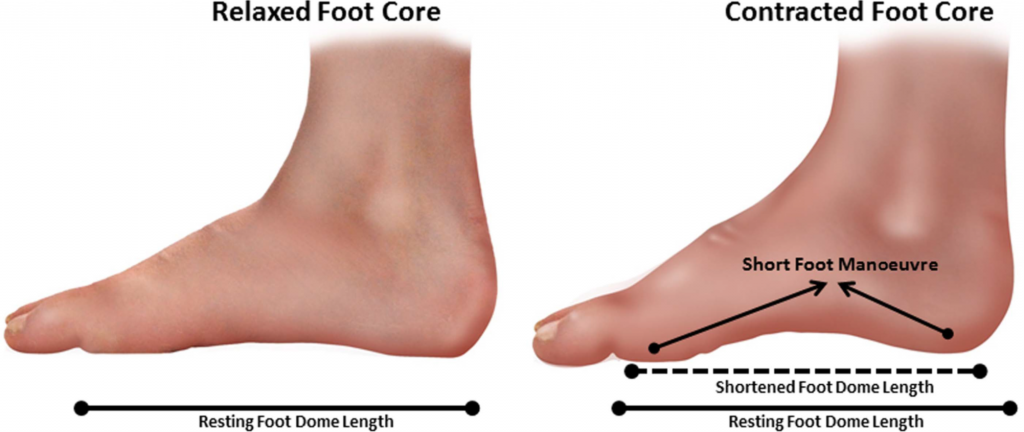Foot/heel/Achilles issues have given me trouble over the years. The same issues are the scourge of many a runner. Plantar Fasciitis, Achilles tendon pain and metatarsalgia are a few of the problems one can experience as a result of faulty foot and lower-leg mechanics.
The causes of these injuries are often multi-faceted and thus are the solution(s). It seems that weakness of the foot muscles may be a prominent issue. One idea on the mechanism of plantar fasciitis is that the intrinsic foot muscles do a poor job of controlling forces going through the foot. If the stresses of running and walking aren’t distributed adequately then we may overstress the plantar fascia and that may trigger pain. We then need to find a way to unload the stressed tissues. (Please note that this may or may not be what causes plantar fasciitis. There are a lot of questions on how this and other lower-limb pain develops. This study discusses the poor understanding of plantar fasciitis and the difficulty in measuring foot mechanics.) If weak and underperforming foot muscles are part of the problem then how do we bring them back on line?
Among many strategies to address foot pain is an exercise known as the short-foot exercise or foot doming. As the name implies, this exercise has you using the intrinsic foot muscles to create a dome by pulling the metatarsal heads (balls of the toes) toward the heel, which shortens the length of the foot.
More than anything this is a brain exercise. Chances are that when you first try this exercise you won’t do it very well. You’ll struggle, steam may come out of your ears and you’ll get frustrated. Don’t be a baby and give up immediately though. This is a new skill and it takes focused attention and time to develop skills. Keep at it. It likely won’t take you very long to figure it out. For me, the challenge of mastering this exercise is nothing compared to the frustration of being sidelined by foot pain.
Also, try the exercise on your non-hurting foot. If you’re like me, you’ll find that it’s easier to do which again may be an indicator that the source of your pain are muscles that aren’t doing their job correctly.
You may experience cramping. That’s fine. It means you’re doing the exercise correctly. You can either relax the foot muscles and try again or do what I’ve done and hold the short foot until the cramping passes. It hurts a bit but I’ve found the pain to pass quickly.
The muscles involved in this exercise aren’t given to being big and strong. We need them to work a lot for a long time, so we need to condition their endurance. Therefore we need to hold the short foot position for time and we need to do the exercise often throughout the day. The good thing is you need no equipment to do this and you can do it anywhere. You don’t have to take off your shoes either.
I think this video does a good job of describing the exercise:



I had no idea that there were so many muscles in our feet! It is no wonder mine hurt so bad after a going for a run. I’ve been trying to stretch before and after, but I haven’t heard of the “short-foot exercise” before. Before my next run, I’ll be sure to give it a try.
Thanks for the reply. It’s very easy to ignore the feet but it’s only every single step that we need them to work well. I find the short-foot drill especially tough on the brain. It’s a difficult skill to figure out how to contract and control those muscles.
Hi Kyle
Am I correct in believing that the short foot exercise is primarily an isometric exercise ? If so I can see why the exercise would help strengthening the intrinsic muscles of the foot as they are used during midstance but wonder if there would be any carry over of performance gain during late stance when the toes are in a more dorsiflexed position and the intrinsics in a more lengthened position .
Gerry
Good question. When I do the short foot exercise there is some movement–but not much. (Maybe it’s a quasi-isometric?) Maybe the best way to get some transfer to the position you mention is to try the short-foot drill in that position. I would imagine there would be very little movement. Maybe to get even more transfer we might hold the short-foot position while we executed ankle dorsiflexion and plantarflexion. Seems like we would get some eccentric work to the intrinsics that way. Personally, I sometimes think of grabbing the ground while I run. I think of grabbing a bunch of dirt. So I think I’m doing the short-foot drill while in motion.
Kyle ,I recently read a paper (1) which reported that the plantar fascia is under the greatest strain during push-off . Perhaps that is why some suffers of plantar fasciitis report pain during this phase of gait . If the short foot exercise is primarily an isometric exercise then perhaps some additional strengthening of the plantar intrinsics to assist the fascia whilst the toes are in a dorsiflexed position might be a good idea .
Gerry
(1)Yaodong Gu ,Zhiyong Li ; Mechanical Information of Plantar Fascia During Normal Gait ;2012 International Conference on Medical Physics and Biomedical Engineering
Your reasoning sounds very accurate to me. If we think about the SAID principle then we should be looking to create strength in the exact positions in which we need it. Putting the toes in dorsiflexion while doing the short-foot drill seems 100% the right idea.
Kyle – Great video. I find when doing the short foot exercise that I get a lot of pain in my outside ankle. Maybe I’m using the wrong muscles – or maybe I just have weak ankles and really need to do this exercise more!
Thanks for the comment and I’m sorry to hear your ankle bothers you when you do the short foot drill. I can’t be certain at all but could it be some sort of intense stretch that you’re feeling? If it continues to be a problem then I suggest seeing a physical therapist, podiatrist, chiropractor or some sort of injury rehab professional.
In my opinion there are 2 windlass phase during gait ,the initial windlass phase and the second windlass phase . These are explained in the link provided at the end of this post .
The initial windlass phase ,which begins with dorsiflexing of the toes prior to foot contact , is important in avoiding excessive strain in the plantar fascia .
Since the short foot exercise is primarily a neuromuscular exercise I believe it should be avoided until its effects on the functioning of the initial windlass mechanism can be established .
Gerry
Link
Windlass mechanisms – plural – and diabetes – Biomch-L
https://biomch-l.isbweb.org/threads/31054-Windlass-mechanisms-plural-and-diabetes
2 Mar 2018 – 1 post – 1 author
Post 1 So during the gait cycle the windlass mechanism is engaged and reversed twice . Going from heel strike to heel strike we have windlass …
.
Kyle ,
At the end of this post is a link to a video of Haile Gebrselassie running barefoot which clearly shows the lifting of the toes prior to foot strike . When the foot lands on the ground the fascia ,which is wrapped around the MTFJ , can be paid out by the eccentrically contracting toe dorsiflexors . This mechanism , which is a bit like the arrestor cable on an aircraft carrier , allows the strain within plantar fascia to be controlled , preventing overloading .
If a person wears shoes which restrict the lifting of the toes during walking or running , then the toe dorsiflexors have to work harder perhaps leading to shin splints .
The solution to this problem ,then , might be as simple as buying shoes with a woven , easy to displace , fabric covering at the front of the shoe so that the toes can easily “lift ” .
Haile Gebrselassie slowmotion left barefoot – YouTube
Video for haile gebrselassie slow motion running▶ 1:04
https://www.youtube.com/watch?v=Tek2JuRcO_w
6 Oct 2014 – Uploaded by Light Feet Running / Le Guide du Crawl Moderne
Haile Gebrselassie slowmotion left barefoot. Light Feet Running / Le Guide du Crawl Moderne. Loading .
It strikes me that the short foot exercise (as described by Janda ) is useful because it strengthens the extrinsic , arch supporting muscles , rather than the intrinsics .
Such muscles include the tibialis posterior and peroneals which are know to lift the arch of the foot in closed chain ( foot on the ground ) .